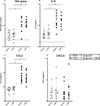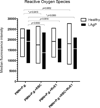Porphyromonas gingivalis-induced production of reactive oxygen species, tumor necrosis factor-α, interleukin-6, CXCL8 and CCL2 by neutrophils from localized aggressive periodontitis and healthy donors: modulating actions of red blood cells and resolvin E1
- PMID: 27146665
- PMCID: PMC5097708
- DOI: 10.1111/jre.12388
Porphyromonas gingivalis-induced production of reactive oxygen species, tumor necrosis factor-α, interleukin-6, CXCL8 and CCL2 by neutrophils from localized aggressive periodontitis and healthy donors: modulating actions of red blood cells and resolvin E1
Abstract
Background and objectives: Porphyromonas gingivalis is regarded as a significant contributor in the pathogenesis of periodontitis and certain systemic diseases, including atherosclerosis. P. gingivalis occasionally translocates from periodontal pockets into the circulation, where it adheres to red blood cells (RBCs). This may protect the bacterium from contact with circulating phagocytes without affecting its viability.
Material and methods: In this in vitro study, we investigated whether human peripheral blood neutrophils from 10 subjects with localized aggressive periodontitis (LAgP) and 10 healthy controls release the proinflammatory cytokines interleukin (IL)-6, tumor necrosis factor α (TNF-α), the chemokine (C-X-C motif) ligand 8 (CXCL8; also known as IL-8) and chemokine (C-C motif) ligand 2 (CCL2; also known as monocyte chemotactic protein-1) and intracellular reactive oxygen species (ROS) in response to challenge with P. gingivalis. In addition, the impact of RBC interaction with P. gingivalis was investigated. The actions of resolvin E1 (RvE1), a known regulator of P. gingivalis induced neutrophil responses, on the cytokine and ROS responses elicited by P. gingivalis in cultures of neutrophils were investigated.
Results: Upon stimulation with P. gingivalis, neutrophils from subjects with LAgP and healthy controls released similar quantities of IL-6, TNF-α, CXCL8, CCL2 and intracellular ROS. The presence of RBCs amplified the release of IL-6, TNF-α and CCL2 statistically significant in both groups, but reduced the generation of ROS in the group of healthy controls, and showed a similar tendency in the group of subjects with LAgP. RvE1 had no impact on the production of intracellular ROS, TNF-α, IL-6, CXCL8 and CCL2 by neutrophils from either group, but tended to reduce the generation of ROS in subjects with LAgP in the absence of RBCs.
Conclusions: Our data support that binding to RBCs protects P. gingivalis from ROS and concomitantly enhances neutrophil release of proinflammatory cytokines providing a selective advantage for P. gingivalis growth.
Keywords: Porphyromonas gingivalis; aggressive periodontitis; cytokines; neutrophils; red blood cells; resolvin.
© 2016 John Wiley & Sons A/S. Published by John Wiley & Sons Ltd.
Conflict of interest statement
Figures




References
-
- Cassatella MA. Neutrophil-derived proteins: selling cytokines by the pound. Adv Immunol. 1999;73:369–509. - PubMed
-
- Chapple ILC, Matthews JB, Wright HJ, Scott AE, Griffiths HR, Grant MM. Ascorbate and α-tocopherol differentially modulate reactive oxygen species generation by neutrophils in response to FcγR and TLR agonists. Innate Immun. 2012;19:152–159. - PubMed
-
- Sugita N, Kimura A, Matsuki Y, Yamamoto T, Yoshie H, Hara K. Activation of transcription factors and IL-8 expression in neutrophils stimulated with lipopolysaccharide from Porphyromonas gingivalis. Inflammation. 1998;22:253–267. - PubMed
-
- Cassatella MA, Meda L, Bonora S, Ceska M, Constantin G. Interleukin 10 (IL-10) inhibits the release of proinflammatory cytokines from human polymorphonuclear leukocytes. Evidence for an autocrine role of tumor necrosis factor and IL-1 beta in mediating the production of IL-8 triggered by lipopolysaccharide. J Exp Med. 1993;178:2207–2211. - PMC - PubMed
MeSH terms
Substances
Grants and funding
LinkOut - more resources
Full Text Sources
Other Literature Sources
Research Materials

